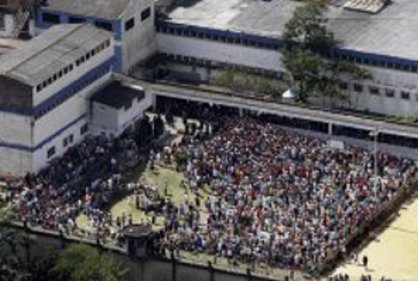Colombian Prison Strikes Continue-Inhumane Conditions “Made in the USA”

Torture is so commonplace in the jails that a 2008 study by Colombia’s Committee in Solidarity with the Political Prisoners showed that when asked if the inmates had been tortured at least once during their jail time, 54% answered they had and 46% did not answer the question at all. Eighty-six percent said that they had experienced psychological torture, including threats to relatives and simulated executions.
Conditions in Colombian prisons should be of special concern for residents and citizens of the United States. In 2000, the US Ambassador signed an agreement with the Colombian Minister of the Interior named the Program for the Improvement of the Colombian Prison System (PICPS). Under the PICPS, the US would help build a series of new prisons to create a “New Penitentiary Culture”. This effort has been funded and advised via USAID (United States Agency for International Development) and the US Bureau of Prisons.
One reason given for this program was to alleviate overcrowding. However, rates of arrests went up far more quickly than new jails and the number of political arrests that were later thrown out of court for lack of evidence rose by 300% (with most of the accused spending two to three years in jail before release). This does not include political prisoners who have been convicted for their activities. The estimated number of political prisoners has grown from 7,200 to over 10,000 since 2008.
New jail construction has been less about relieving overcrowding than preparing for a much larger prison population as a result of social and economic disruption and punishing political dissent. With passage of the US-Colombia Free Trade Agreement many observers fear that poverty rates will worsen and crimes of desperation and prison populations will increase. Unfortunately, US and Colombian authorities see the “New Penitentiary Culture” as a model and are seeking to replicate it in Central America (where in Honduras the US has announced a new “Model Penitentiary” program) and Mexico (where the US is funding construction of 16 new federal prisons).
According to Tulio Murillo Avila, who is a national spokesperson for the Movimiento Nacional Carcelario (National Movement in the Jail),
Jail over-population…is not a new thing,
being found today at a national level of 47%, due to the policies of
punishment…in the new centers of incarcerations constructed under the
influence of the US Bureau of Prisons. In some jails the overcrowding
has reached 400%.

Bellavista Jail in Medellín
The first prison constructed with US funding and advice was La Tramacúa, located in the city of Valledupar. Although a “modern” facility built on the basis of US designs, it has become infamous for its terrible conditions. La Tramacúa has been found on at least three occasions (by agencies from the United Nations and the Department of César, as well as by an internatinoal NGO) to be serving food tainted with fecal matter. Sanitary facilities are rarely working and inmates are forced to relieve themselves in buckets and plastic bags which are “disposed of” by being thrown over prison walls.
In 2010, Raquel Mogollón, a member of the Alliance for Global Justice “Colombia Watch” working group, had the chance to visit La Tramacúa with a delegation of Colombian legislators and international human rights defenders. According to Mogollón,
…Inmates say they’re getting access to
water about ten minutes a day. However, in the cells there is
water…disgusting, dirty water on the floors. [Editor's Note: Past
visitors at La Tramacúa have reported that sewage lines often overflow
and open sewage runs by kitchen facilities.]
The prison was absolutely, suffocatingly
hot with just a few water pipes. What was really bad–I got a look at the
water bottles. They were all full of mold. They aren’t able to clean
their water jugs. There’s just not enough water available. At one point,
you could hear the water coming through the pipes. All the men started
running….
The whole place smelled. They said it was
cleaned up for us. Mostly, it smelled like urine. They said the bags of
feces had been gotten rid of….
The kitchen area was totally dark. They
said they’d cleaned that up, too, but it wasn’t that clean. There were
three fans and ten giant cauldrons where they were cooking some soup or
stew. In the other room where they prepared the food, it was full of
flies. There was grease all over the floor. It didn’t smell very good. I
saw vegetables and fruit that were spoiled in the preparation area,
with flies all around them.

Prisoner collecting daily water at La Tramacúa
The prisoners have formulated an additional five basic demands:
- Declare a Social and Humanitarian Emergency in Colombian jails;
- Regionalize prisoners in institutions near their families;
- Reduce all sentences by 20% and increase the use of alternative sentences such as home detention;
- Resolve problems of health, sanitation and overcrowding;
- End the extradition of prisoners to foreign countries (which is interfering with Colombia’s internal peace process and in ongoing investigations of links between paramilitary death squads and Colombian politicians).
…prisoners of the La Modelo jail in
Arauca informed us that, in the morning hours, INPEC guards physically
attacked four prisoners in Patio One…in reprisal for their participation
in the National Days of Protest…..The attacked prisoners were placed in
solitary confinement instead of being…attended by medical personnel….
The 12th of August of 2012, in
the afternoon hours, spokespersons for the 34 hunger strikers at the
Penitentiary Complex of Picaleña (Ibagué, Tolima), informed us that the
state of the strikers has deteriorated, [and they are] suffering severe
dizziness, nausea, stomach sickness, cramps, fainting and decreased
mobility, without INPEC offering adequate medical attention….
Of particular concern at La Picaleña has been the condition of
prisoner spokesperson Alba Libia Esquivel whose health has been
especially affected. Esquivel has been on a hunger strike since August 8th.Lazos also reported that on August 23,
…in the afternoon hours, the Immediate
Reaction Group (GRI) of INPEC entered the High Security Penitentiary in
Combita, Boyacá, in a violent manner, proceding to launch tear gas and
to beat the strikers, leaving various wounds….Those wounded have been
taken in stretchers from their units, their whereabouts unknown.”
…in the jail of Valledupar, “La
Tramacúa”…inmates of Tower Four climbed the structure as a form of
protest of the present crisis in the jails. In the morning hours…Sgt.
Lucio entered with a group of guards launching tear gas and repressing
the protest and attacking the inmates with clubs. The prisoner Wilson
Jiménez Mora, who was found suspended from the structure, was thrown
from the third floor resulting in a fractured leg.
Mogollón tells of a particularly poignant encounter she had while visiting inside La Tramacúa:
The worst thing, the worst kind of
torture, wasn’t any kind of violence or anything like that. It seems
little, but so many people came up to me and told me about not being
able to see their families, being completely shut off. When we walked
between the Towers, the prisoners were all bunched up around the gates.
People would be calling to me, ‘Doctora! Doctora! Madre! Madre!’ They
would want me to write their names down.
One man said, ‘I’ve been here eight years! I can’t see my daughter!’
Another said, ‘I’ve been here twelve years and I haven’t seen my mother the whole time!’
It was one plea after another like that,
people who hadn’t seen their families for years. When I asked why, one
man responded, ‘We’re poor. Our families can’t afford to make the long
trips. And when we think of them coming in here, how it smells like
feces, it’s so humiliating, so disgusting. It is so hard to think of
them seeing us like this.

We
would have to walk through these passageways that crisscrossed among
the different units. All the prisoners would be crammed up at the gates
and windows, calling to me, “Doctora! Doctora!’ or ‘Madre! Madre!’. I
would put my hand up just to acknowledge them. They would give me papers
with their names on them. One inmate called to me, ‘Please, please,
Madre! I’ve been here six years and I have two hernias. I can’t get
treatment, I can’t get medicine!’
Another told me, ‘Look, you’ve got to listen! There is no re-socialization here! There’s no such thing!’
Finally, at one point I stopped in one of
the passageways and spoke back to them. I said, ‘Look, I wish I could
help each one of you, but I can’t! I can’t because this place is modeled
on a US system. This model is based on punishment and the people who
designed this system don’t care about re-socialization. They don’t care
what happens to you! All I can do is to go back and do what I can to
change this whole system and draw attention to what you are suffering.
All of a sudden, they started clapping, yelling, ‘Go on!’ and ‘You speak the truth!’
Here are some things that you can do.
- Cut and paste the follwing sample in Spanish or write your own message and email it to the following Colombian, United Nations and US State Department Officials, and to AfGJ, at:
Todo el mundo esta observando lo que pasa en los penitenciarios en Colombia. Sabemos del hacinamiento; que las cárceles no están proviendo a sus internos las necesidades básicas como comida y agua limpia y servicio desalud; que violencia en contra de las presas y los presos es epidémico; que los servicios de resocialización son limitados y en vez se favorecen las políticas de castigo y negligencia. Yo apoyo a los y las huelgistas de las cárceles colombianas que exigen condiciones mejores y especialmente apoyo la declaración de Estado de Emergencia Carcelaria y el establecimiento de una Mesa Nacional de Concertación que incluye portavoces para las presas y los presos con la meta de resolver esta situación.
In ENGLISH:
The whole world is watching what is taking place in Colombian prisons. We know that Colombian prisons are overcrowded; that many prisons are not providing their inmates with basic necessities such as clean food and water and basic health care; that violence against prisoners is epidemic; that rehabilitation services are severely limited in favor of policies of punishment and neglect. I support Colombia’s striking prisoners in demanding better conditions and, especially, the declaration of a State of Emergency in the Colombian penal system and the establishment of a National Board of Consultation, including spokespersons for the prisoners, to remedy this situation.
- Call or fax the Colombian Embassy in Washington, DC, using the above sample or your own words. They can be reached at 202-387-8388 or you can send them a fax at 202-232-8643.
- There’s a very good chance that your Representative and Senators in the US Congress do not even know about the US-sponsored PICPS and the “New Penitentiary Culture”. We encourage you to set up a visit with your elected representatives to educate them about this issue and to demand that they use their influence to call on the Colombian government to take immediate action to improve conditions in the prisons and to call for a Congressional investigation of the PICPS and the conditions it has lead to in prisons such as La Tramacúa. We must also ask them to intervene to stop this model from being further imported into Central America and Mexico. If you would be willing to organize such a visit, please send an email to James@afgj.org to receive background material for your visit.







Aucun commentaire:
Enregistrer un commentaire